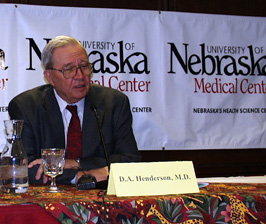Although work continues, the United States has made considerable progress in preparing for the potential of a biological weapons attack and Nebraska is among the states leading the effort, said the man who spent 10 years directing the World Health Organization’s global smallpox eradication campaign.
 “Nebraska is doing brilliantly,” said Donald A. Henderson, M.D., senior science advisor to the Secretary of Health and Human Services.
“Nebraska is doing brilliantly,” said Donald A. Henderson, M.D., senior science advisor to the Secretary of Health and Human Services.
Dr. Henderson spent two days on campus gathering information on UNMC’s bioterrorism preparedness efforts, as well as presenting Thursday’s 21st John S. Latta Lectureship, sponsored by the UNMC College of Medicine Alumni Association.
Dr. Henderson: “A model here”
“What we need now for Nebraska is help in broadcasting what they’ve done because there’s a model here that would be well for other medial center and states to emulate,” he said.
Dr. Henderson is internationally known for his work in public health and the eradication of smallpox around the world. Since Sept. 11, 2001, he has worked to prepare the United States for any bioterrorism event involving weapons of mass destruction.
The Ohio native said he was particularly impressed by the close collaboration between UNMC, public health authorities, the governor’s office and other agencies. He also cited the ingenuity of folding the state’s public health lab into the medical center.
Preparing for smallpox, anthrax
Nationally, he said, officials are focusing their efforts on potential smallpox or anthrax attacks, although preparation efforts will help communities deal with any epidemic event, whatever the source may be. “Nebraska is as well prepared as any place in America and probably better prepared than most,” he said. “If we had an outbreak of smallpox or anthrax today, the state of Nebraska would be equipped to deal with it pretty well.”
Dr. Henderson said he was surprised to learn that the Soviet Union had a program of developing biological weapons and specifically a program to weaponize smallpox – at the same time its public health sector was helping with the World Health Organization’s global eradication program. “Specifically they developed and manufactured the planned capacity to produce between 20 and 100 tons of dried smallpox virus a year for ICBMs (Intercontinental Ballistic Missile),” he said.
“During the global eradiation program, which extended from 1967 to the last case in 1977, the Soviet Union was a major contributor to the program, along with us. They regularly gave us 25 million doses of vaccine a year, scientist worked on special program problems we hadn’t solved, they served in the field as epidemiologists in controlling the outbreaks and they are extremely proud of this program. It was hard for me to believe that part of the government had been engaged in producing smallpox virus on a large scale,” he said.
Lessons from the past
The global eradication program yielded several lessons, Dr. Henderson said, including:
- Smallpox does not spread rapidly like wildfire, he said. Unlike measles, individuals don’t spread the virus until they get sick. As a result, ring vaccinations, or containment methods, were effective in controlling the outbreak of the disease.
- While most vaccines have to be given well before individuals are exposed to the disease, “smallpox is unique,” he said. The smallpox vaccine actually can provide protection if it’s given two to three days after an individual is exposed to the disease.
- Multiple puncture vaccinations, done with a bifurcated needle developed in 1966, are effective. Prior to the “miracle invention,” vaccinations were scratched or pressed into the skin, he said.
Preparations since 9/11
Following Sept. 11, Dr. Henderson said, the fear of a potential biological weapons attack produced some “uneasy days,” particularly after learning there was a smaller-than-anticipated supply of smallpox vaccine in stock. Since then, the United States has increased the production of the vaccine, as well as vaccine immune globulin, which is used to treat serious reactions.
What is the threat?
So how large of a threat is smallpox? “Our assessment is the risk is small,” Dr. Henderson said. “It’s less than the risk of a release of anthrax. The difficulty is it is spread from person to person. Anthrax is not.” In addition, smallpox has a death rate of 30 percent with no treatment, he said.
“The genie is out of the bottle with regard to biological weapons,” Dr. Henderson said. “We now know it’s possible. This is a threat that’s going to be with us for a long time, unhappily, and we need to be prepared to deal with it.”